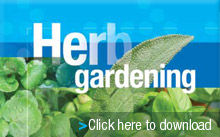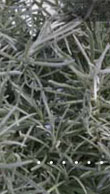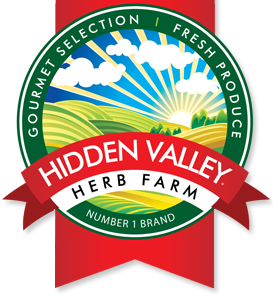Top 15 Herbs
Health benefits and harvest information
|

|
| |
Basil |

Harvest
Continuous or as required
Position
Full Sun
or Semi Shade
20cm apart
Planting Time
Jan - Dec
|
Uses
A companion planting for tomatoes to repel whiteflies. Great in pasta dishes, Italian Pesto and Pasta sauces and Vinegars. Coloured foliage varieties can be used for borders and companion plantings.
Health Benefits
- High in Vitamin C, Vitamin A, Calcium, Phosphorus and Potassium
- Powerful antioxidants combat cancer forming, skin ailments (acne), and viral infections such as colds and the flu
- Combats bowel inflammation, stomach aches and rheumatoid arthritis
- Enhances blood circulation, stabilizes blood sugar levels and improves respiration
|

| |
Chives |

Harvest
As required taking the outside leaves rather than whole plant
Position
Full Sun or Semi Shade
30cm apart
Planting Time
Jan - Dec |
Uses
Chopped leaves can be used in salads, soups and egg dishes.
Grows well in large pots forming clumps.
Health Benefits
-
Benefits the circulatory, digestive and respiratory systems
-
Aids digestion and stimulates appetite (when finely chopped and consumed with food)
-
Can help the body in digesting fatty foods, such as cheese
-
Good remedy for those suffering from tiredness and fatigue
-
Can reduce obesity and fluid retention
-
Helps reduce the risk of prostate cancer
-
Contains mild anti-inflammatory properties
|

| |
Coriander |

Harvest
Autumn to Spring
(for leaves)
Summer (for seeds)
Position
Full Sun or Semi Shade
20cm apart
Planting Time
Jan - Dec |
Uses
One of the most cosmopolitan of ancient herbs, leaves and seeds can be used to suit your cooking style. Over the years Coriander has been widely used in traditional cooking methods but also in medicines. Mature seeds are used for flavouring salads, bread and confectionary. Leaves can be used in many different dishes; Lebanese, Asian, and most meat dishes for flavouring.
Health Benefits
-
Leaves act as stimulants and tonics
-
Leaves strengthen the stomach and promote digestion
-
Seeds reduce fever and offer a feeling of coolness
-
Provides vitamins A, B1, B2, C and iron
-
Coriander water helps lower blood cholesterol
-
Seeds are known to alleviate excessive menstrual flow
|

| |
Parsley |

Harvest
Continuous or as required
Position
Full Sun to Semi Shade
Planting Time
Jan - Dec |
Uses
Both leaf forms can be used fresh as a garnish and fresh or dried to flavour salads, vegetables, meats, stews, soups and egg dishes. Suitable for growing in large tubs or in the garden as a perpetual herb or border.
Health Benefits
- Three times as much Vitamin C as Oranges
- Twice as much Iron as Spinach
- Excellent source of Vitamins K & A
- High antioxidants to fight cancer
- Good for heart and Cardiovascular health
|

| |
Spinach |

Harvest
At 8-10 weeks
frequently pick outside leaves (a cool season,
short day crop)
Position
Full Sun
Planting Time
Mar - Aug |
Uses
Best cooked immediately after picking but can be refrigerated up to a week. Can be steamed, boiled or used fresh in salads.
Health Benefits
- The highest vitamin rich vegetable of them all; includes folate, Vitamins A, B1,2 & 6, C, & K
- High in Iron and other trace minerals
- Rich in beta-carotene, and lutein
- Low fat content lowers cholesterol which reduces heart attacks and strokes
- Anti-cancerous properties (including vitamins, antioxidants and minerals) act to treat and protect from various kinds of cancer (bladder, prostrate, liver and lung)
- Eye Care - eyesight, dry eyes, ulcers, itching, protects from UV, prevents cataracts
- Controls insomnia
- Helps treat skin diseases and strengthen immune system
- Blood Pressure - reduces hypertension, relaxes blood vessels and maintains blood flow
- Strengthens muscles - antioxidants assist in strengthening heart muscles and treating
- Cardiovascular diseases
- Neurological benefits - various antioxidants provide benefits for occurrences such as Alzheimer’s disease
- Bone mineralisation - can assist in preventing Osteoporosis through retaining calcium and Building of stronger bones
- Assists infant’s growth through mother’s diet - will lessen likelihood of spinal bifida, cleft palate and proper development of fetus nervous system
|

| |
Oregano |

Harvest
Continuous
Position
Full Sun
Planting Time
Mar - Dec |
Uses
Use fresh or dried in Italian, Spanish and Mexican dishes, especially with pasta and tomato. Also known as wild marjoram this perennial herb has a distinct aroma and flavour.
Health Benefits
- The essential oil and alcoholic extract of leaves are used as an antioxidant, and also for antifungal and antibacterial uses
- Anti-parasitic properties help in controlling a number of ailments related to the digestive system
- Oregano oil helps in treating skin infections, itchy skin and irritated gums, when applied topically
- Oregano oil is also beneficial in the treatment of sinus or lung congestion
- Helpful in maintaining good respiratory health
- Helps increase the joint and muscle flexibility
- Useful for general strengthening of the immune system
|

| |
Sage |

Harvest
Continuous or as required
Position
Full Sun
30 cm apart
Planting Time
Jan - Dec |
Uses
Fresh or dried leaves are traditionally used to flavour seasonings for poultry, pork, lamb and beef. A perennial herb with long grey green fragrant foliage and brilliant tall spikes of violet blue flowers. Quite hardy in dry conditions and can be used as a herb or a perennial border.
Health Benefits
- Sage oil contains the chemical substances alpha- and beta-thujone, camphor, and cineole as well as other constituents including rosmarinic acid, tannins, and flavonoid
- May be used as a gargle for sore throat and inflammation of the mouth and gums
- Sage oil may offer antibacterial, antifungal, and antiviral effects
- Commonly used for upset stomach and excessive sweating
- Useful for some symptoms of menopause
|

| |
Marjoram |

Harvest
As required
Position
Full Sun
20cm apart
Planting Time
Mar - Dec |
Uses
Fresh or dried used for flavouring of meat dishes.
A perennial herb often grown as an annual. Oval leaves and small white flowers make this an ideal patio pot. Also known for its sweet scent reminiscent of nutmeg.
Health Benefits
- Widely used in aromatherapy, and also as a warming and soothing massage oil to provide relief for muscular ache
- Helpful in fighting asthma; headaches; and soothing the stomach and digestive tract
- Acts as a decongestant and useful in bronchitis, sinusitis and sinus headaches
- Used as a tonic for the nervous system, marjoram is believed to be more calming than oregano, as it is used to soothe the nerves, reduce tension and stress
- Flavonoids found in the leaf have sedation qualities which help to relieve insomnia, tension headaches and migraines
- Promotes healthy digestion and treats simple gastrointestinal disorders, such as loss of appetite, indigestion, nausea and flatulence
- Anti-inflammatory properties can alleviate toothaches, muscular pain, bruises, arthritis, sprains and stiff joints when used externally, and ease severe stomach cramps, spasms and painful menstruation when used internally
- Helps in the reduction of fevers, and helps to relieve cold and flu symptoms
|

| |
Mint |

Harvest
Perpetual as required
Position
Prefers shade and damp conditions
Planting Time
Jan - Dec |
Uses
Use fresh mint in drinks, food and as a garnish. Can also be used for mint sauce or mint jelly. A spreading perennial best controlled in a large pot or tub.
Health Benefits
- Strong mint tea helps in soothing the digestive tract and easing the severity of stomachaches
- Drinking herbal mint tea reduces irritated bowel syndromes and cleanses the stomach
- Strong diuretic, also helpful in eliminating toxins from the body
- Reduces the growth of bacteria and fungus in the body (when consumed in a regular diet)
- Antifungal properties help in curing asthma and other allergic conditions
- Crushed mint leaves help in whitening teeth
- Helps to get rid of headaches and migraines
- Inhaling mint gives relief from congestion problems, like sinus infections and common cold
|

| |
Dill |

Harvest
In the first 8-12 weeks harvest young foliage,
then harvest seed yield when flowered
Position
Full Sun to Semi Shade
30cm apart
Planting Time
Jan - Dec |
A hardy annual herb with light green, feathery leaves and umbrella shaped flower heads. Leaves have a pungent, bitter sweet taste.
Uses
Leaves can be used fresh to flavour chicken, fish, egg and potato dishes, while seeds can enhance vinegars, pickles, breads, crackers, cookies, cakes and pies.
Health Benefits
- Used to induce sleep and relieve insomnia
- Very good source of calcium which is important for reducing the bone loss that occurs after menopause and in some conditions such as rheumatoid arthritis
- Crushed dill seeds, when diluted with water, can be used as a nail-strengthening bath
- When chewed, dill seeds can be highly effective in curing bad breath
- Dill tea, made from seeds, is popular for controlling flatulence
- Can be used to relieve stomach symptoms
|

| |
Curry Plant |

Harvest
As required
Position
Full Sun
Planting Time
Jan - Dec |
Uses
Great accent foliage plant for gardens, rockeries, patio pots, potpourri, wreaths, and for cooking in soups and casseroles. With its very strong odour this plant really does smell of curry, however the food source is not derived from this herb. It’s more common for its pleasant aroma, used as a small shrub or topiary with its soft silver/grey foliage.
The medicinal oil extracted from Curry Plant is known as Helichrysum essential oil, and although it is costly and rarely available, unlike other essential oils it can be stored for a very long time.
Health Benefits
- Helichrysum essential oil offers the following benefits:
- Used as an antiseptic
- As a fungicidal it helps to prohibit and inhibit fungal infections
- Relieves inflammation and soothes body
- Keeps the nervous system in order, strengthens and protects it from disorders
- Makes the skin smooth, soft and helps it retain moisture, preventing it from dehydration and cracking
- Helps in the growth of the body, particularly beneficial for growing children or children who have obstructed growth
- Keeps spleen healthy and free from infections
|

| |
Rocket |

Harvest
Ready for frequent picking at 2-3 weeks
Position
Full Sun
Planting Time
Aug - April |
Uses
A fast growing salad herb with a distinct, bitter, peppery flavour which mixes well with other fresh salad leaves, and can be used in sandwiches.
Health Benefits
- Very low in calories and can be a great source of dietary fiber, vitamins C, A, K and P, iron, potassium and other nutrients and minerals
- Improves blood quality
- Very effective stimulant, giving power and energy
- Posesses vitamins P and K which are reported to have positive effects on liver function
- Should be eaten on a regular basis to prevent most types of cancer
- Wonderful source of chlorophyll, which cleanses and energizes the blood, and helps bring large amounts of oxygen to all parts of the body
|

| |
Rosemary |

Harvest
Continuously as required
Position
Full Sun to Semi Shade
Planting Time
Jan - Dec |
Uses
A pine-like flavour used fresh or dried with chicken and meat dishes (particularly lamb) and stews. An attractive perennial shrub with dark green needle-like leaves and lavender blue flowers. Suitable for large pot and tubs or as a great shrub filler in the garden.
Health Benefits
- Rosemary oil helps strengthen the capillaries and has a rejuvenating effect when applied to the skin
- Treats a wide range of ailments, including stomach upsets, digestive disorders and headaches
- Helps prevent cancer and age-related skin damage
- Helps prevent breast cancer forming by blocking oestrogen hormones
- Boosts the functioning of the liver and acts as a mild diuretic to help reduce swelling
- Disarms harmful toxins and flushes them from the body
|

| |
Thyme |

Harvest
Continuously or as required
Position
Full Sun
30cm apart
Planting Time
Jan - Dec |
Uses
Fresh or dried leaves can be used in soups, stews and for seasoning of poultry, meat and fish dishes. A small, prostrate perennial herb useful as a ground cover in rockeries and garden borders or for container plantings. Thyme is ideal for Australian conditions being very drought tolerant.
Health Benefits
- Thyme oil acts as an antipseptic and disinfectant
- Useful in the treatment of acute and chronic bronchitis, whooping cough, and inflammation of the upper respiratory tract
- Contains cancer preventative properties
- Thyme infused tea mixed with honey and/or lemon soothes lung and air passages, and is also useful for easing menstrual cramps and PMS
- The tea can aid in digestion and help dissolve and remove mucus from the intestinal tract
|

| |
Watercress |

Harvest
At 4-6 weeks
then as required
Position
Full Sun to Semi Shade
10-12 cm apart
Planting Time
Apr - Aug |
Uses
Tasty additions to salads, sandwiches and garnishes. With its leaves delivering a peppery taste and its high Vitamin C contributions, this has become a popular salad herb in a healthy every day diet.
Health Benefits
- Provides an excellent source of vitamins B1, B2, B6, C, E, manganese, and carotenes, and also a good source of fiber, iron, copper, and calcium
- Contains anticancerous properties
- Helps protect the eyes, containing a high level of two carotenoids, lutein and zeaxanthin
- Helps to normalize cholesterol and blood pressure
- Can help improve memory and mental function
- Powerful cleanser of the body, especially the bloodstream
- Low in calories and high in potassium which is valued for weight loss, as its diuretic action draws excess fluid down and out of the body
- Valued for clearing and improving the complexion
- Rich in calcium which can strengthen the bones and teeth
|

|
|

